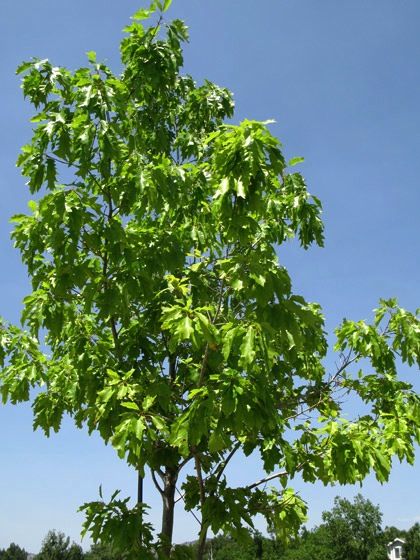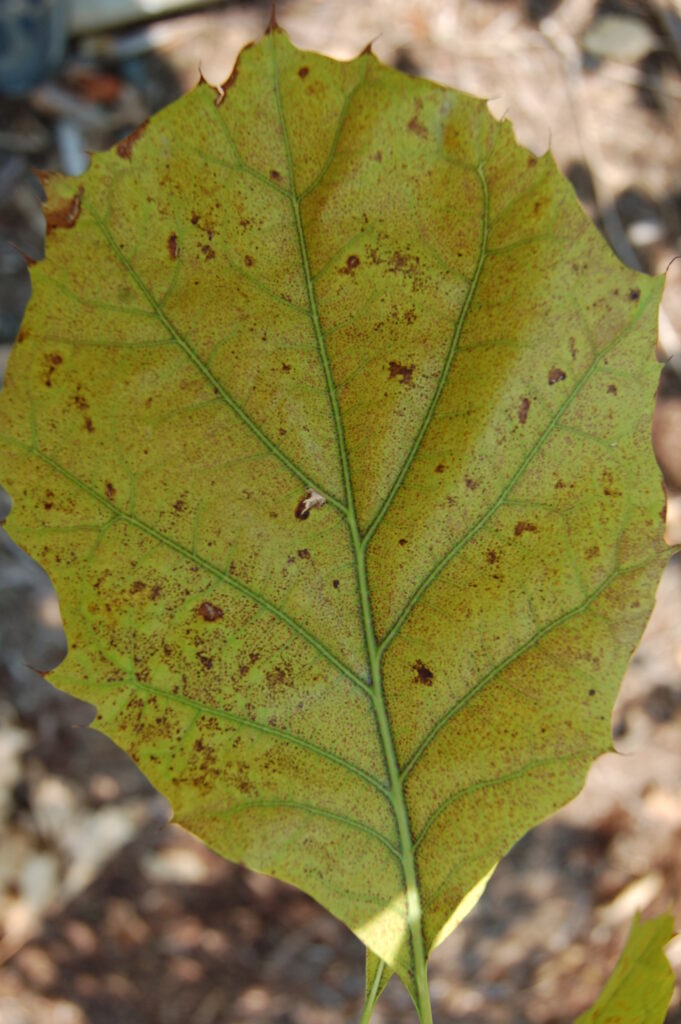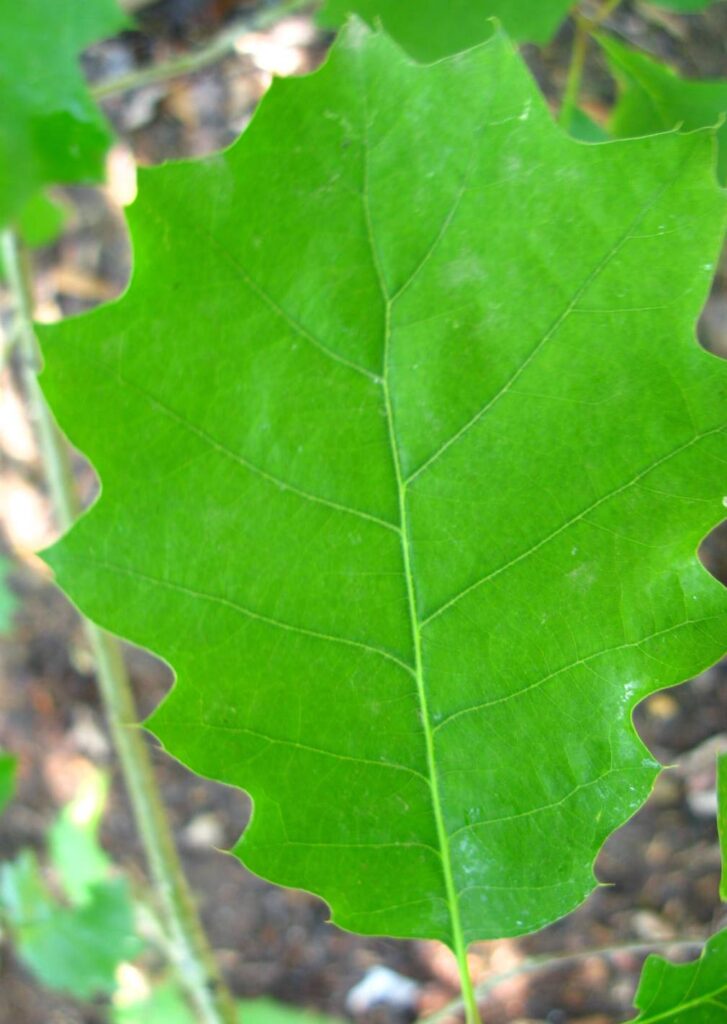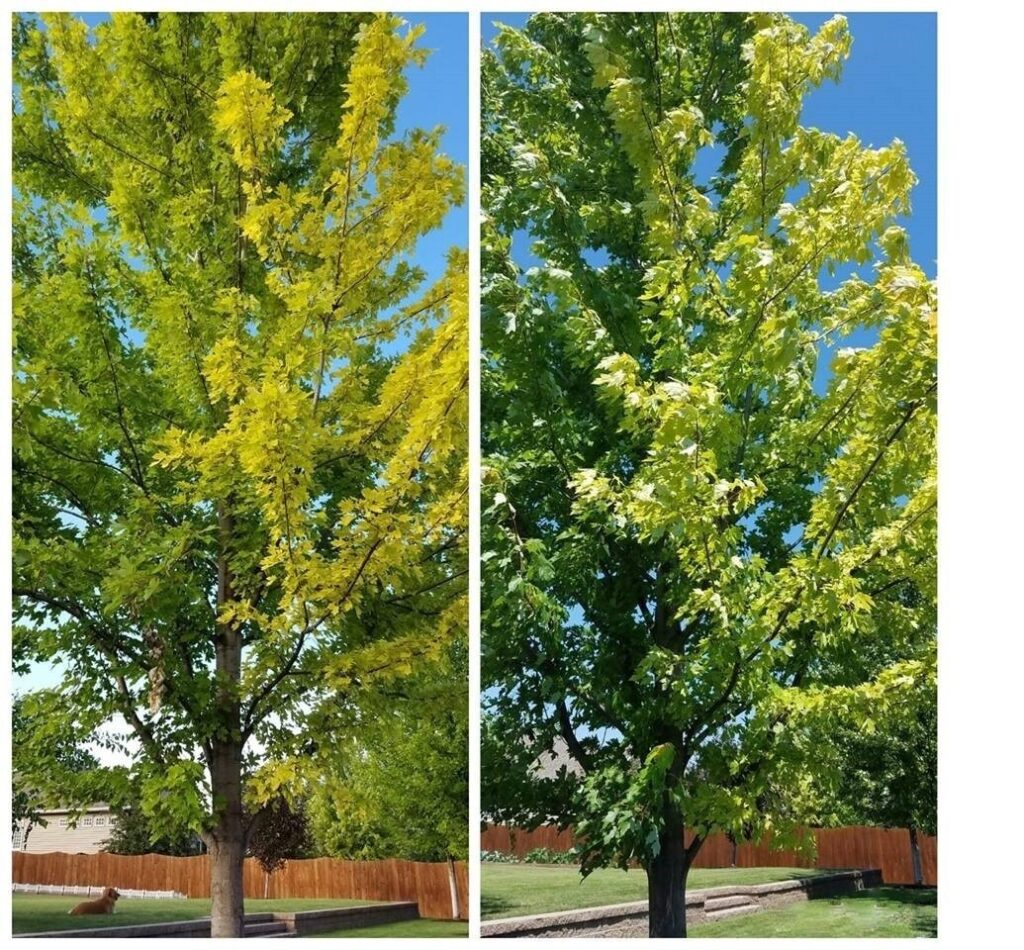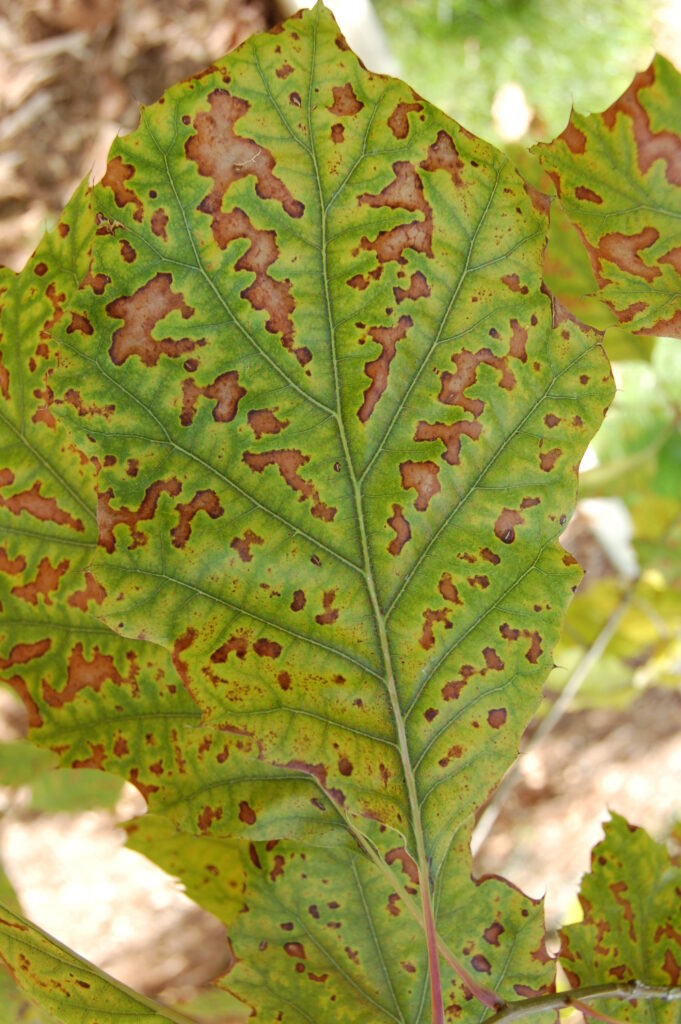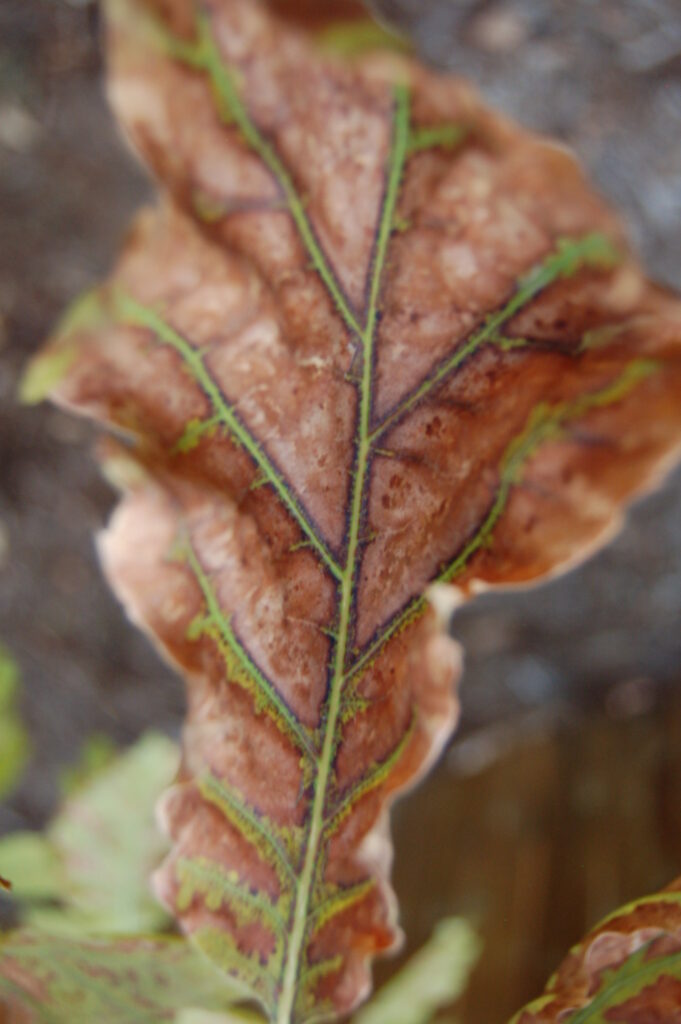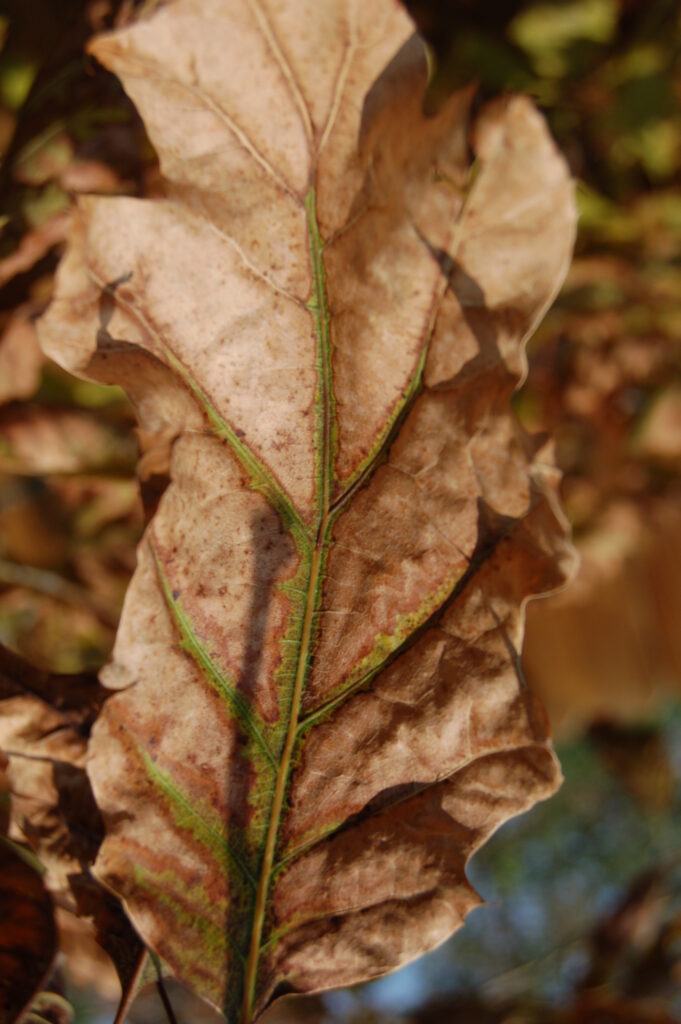IRON CHLOROSIS TREATMENT FOR TREES
Iron Deficiency In Trees
Premature Yellowing Leaves
When a tree suffers from an iron deficiency and becomes chlorotic, it can be frustrating to see the leaves turning yellow and the tree gradually declining. If the tree does not respond to deep root fertilization treatments, we offer a highly effective solution called Tree IV. This treatment delivers a concentrated dose of iron and manganese directly into the trunk of the tree, enabling it to resume chlorophyll production and restore its health.
Tree IV
The Tree IV system operates similarly to an IV for humans. We begin by drilling a few 1/4-inch holes near the base of the tree’s trunk. These holes do not cause significant harm to the tree. Next, we attach injection plugs to the holes and insert injection needles into the trunk. Using air pressure, we then inject a liquid mixture of chelated iron and magnesium directly into the xylem layer of the tree. The tree must accept the concentrated solution of iron and magnesium.
Chlorotic Maple Tree

Fixing a Yellowing Maple or Oak Tree
What Do Chlorotic Leaves Look Like?
Healthy Maple Leaf

Mildly Chlorotic Leaf
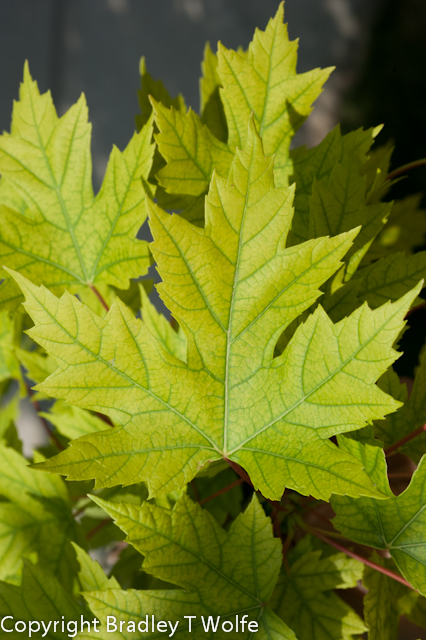
Severely Chlorotic Leaf
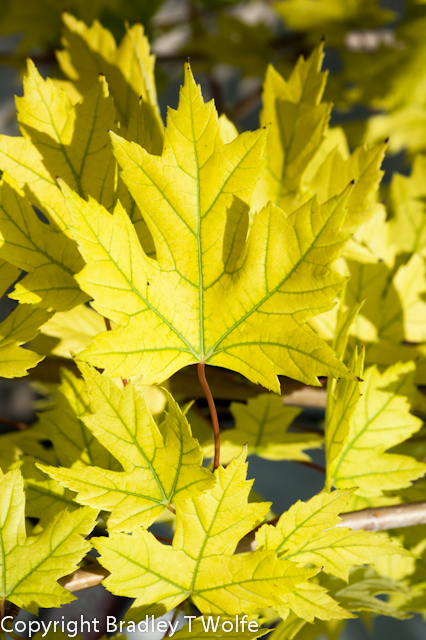
The Stages of Iron Chlorosis
Stage 2
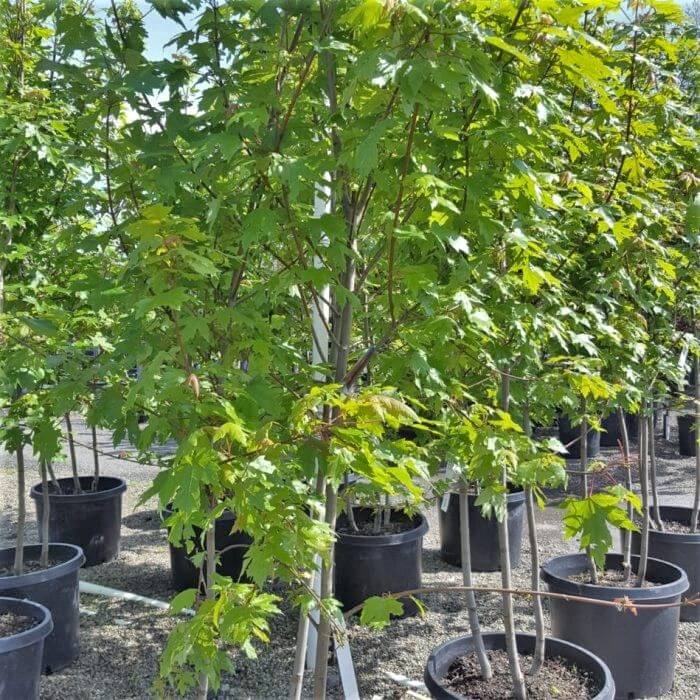
(Click on Image to Enlarge)
Stage 3
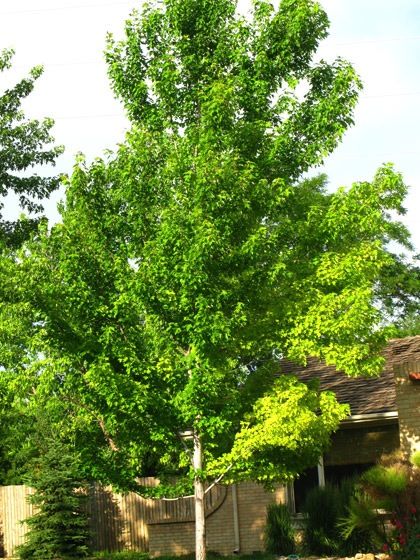
(Click on Image to Enlarge)
Stage 4
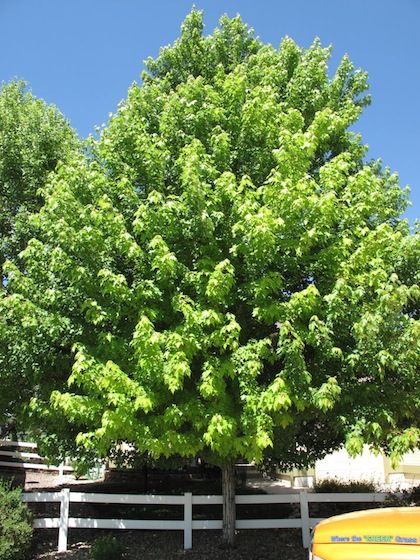
(Click on Image to Enlarge)
Stage 5

(Click on Image to Enlarge)
Stage 6
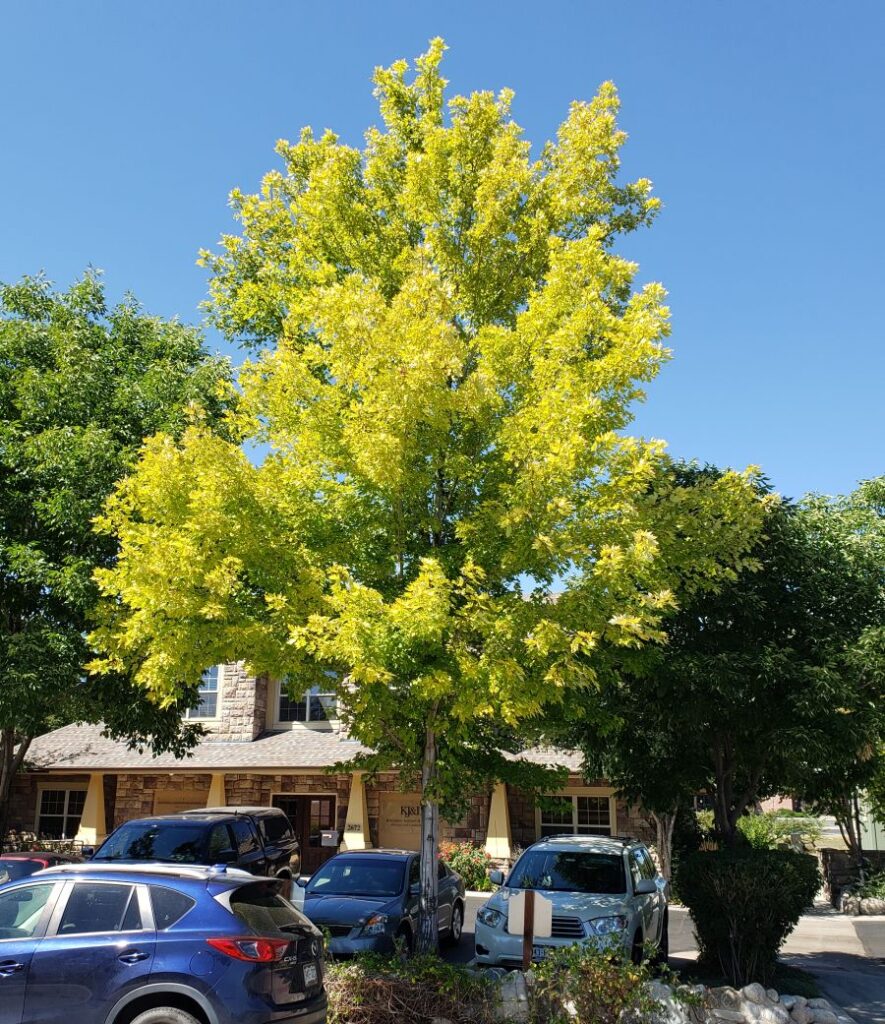
(Click on Image to Enlarge)
Stage 7

(Click on Image to Enlarge)
Stage 8

(Click on Image to Enlarge)
Stage 9
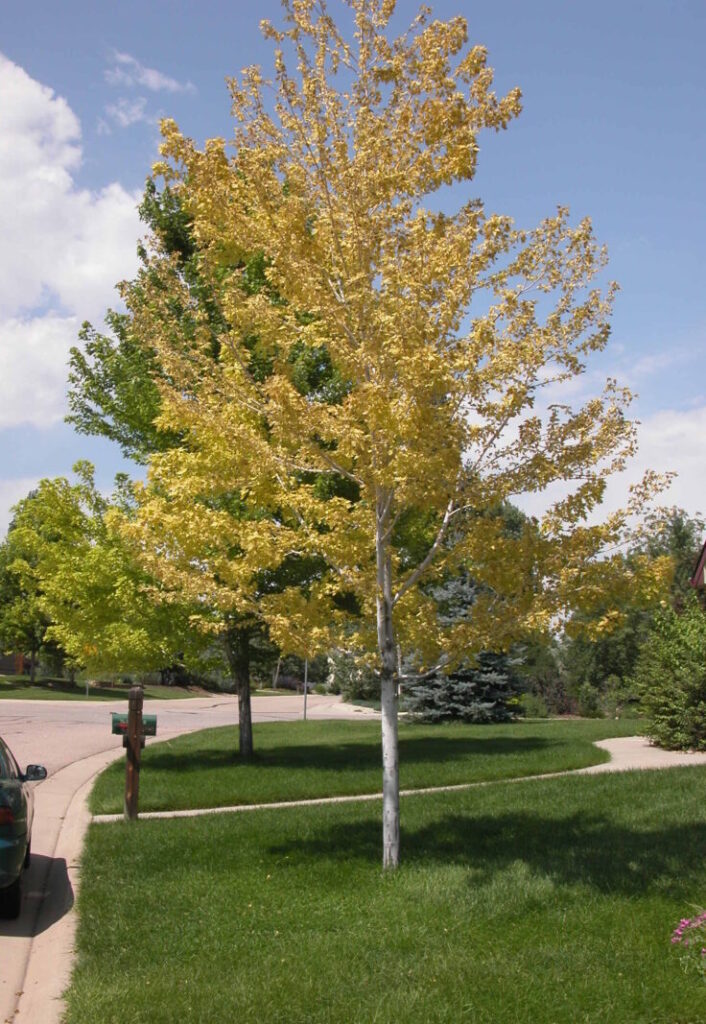
(Click on Image to Enlarge)
Stage 10

(Click on Image to Enlarge)
Stage 10

(Click on Image to Enlarge)
Stage 10

(Click on Image to Enlarge)
Treatment Plan for Chlorotic Trees
Fix the Soil and Jumpstart the Chlorophyll Production
Step 1 – Make Sure the Lawn Watering is Perfect
A sprinkler system audit is essential to ensure that trees are watered according to the 1-2-3-2-1 lawn watering technique which is also designed for tree health. Overwatering can displace air in the soil, depriving the roots of oxygen and harming beneficial microbial activity. Daily lawn watering can also kill soil microbes and encourage shallow root growth in trees. The best approach to watering a lawn is to do it deeply and infrequently, allowing the ground to dry out between watering sessions.
Step 2 – Spring and Fall Tree Fertilization
Spring and fall deep root fertilization with iron is crucial for treating chlorotic trees, especially in alkaline soils where iron becomes unavailable. In the spring, fertilization provides essential nutrients to support new leaf growth and restore chlorophyll production, helping trees recover from winter stress. Fall applications strengthen the root system, allowing the tree to store nutrients for the dormant season and improve resilience for the following year. Deep root fertilization ensures that iron reaches the root zone, enhancing uptake efficiency and promoting long-term health.
The 1-2-3-2-1 Technique

Step 3 – Tree IV Treatment (Usually Performed in September)
Tree IV treatments with iron and magnesium are essential for correcting chlorosis in nutrient-deficient trees, particularly in alkaline soils where these minerals become unavailable. Iron is crucial for chlorophyll production, which restores green leaf color and improves photosynthesis, while magnesium helps activate enzymes and supports overall leaf health. Without these nutrients, trees suffer from yellowing leaves, weakened structure, and increased susceptibility to disease and stress. IV treatments deliver these essential minerals directly into the tree’s vascular system, ensuring faster absorption and more effective recovery than soil treatments alone.
Important Note About Oaks vs Maples
Oak trees generally recover from chlorosis much faster and more easily than maple trees. It is not uncommon for an oak tree to fully recover within one season, while a maple tree may take five years or more to recover completely.
Iron Treatment IV Bottle
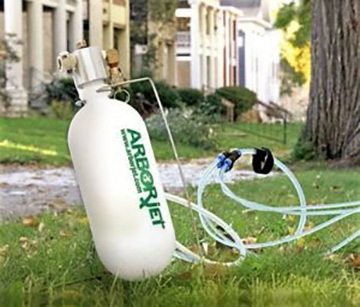
Why Do Oak Trees Respond Faster Than Maple Trees?
Oak Trees
Oak trees generally respond better to iron IV treatments for chlorosis compared to maple trees due to differences in their vascular system and nutrient uptake efficiency. Oaks, particularly pin oaks and red oaks, have a more robust vascular structure that allows them to absorb and utilize injected iron more effectively, leading to a quicker and more sustained recovery. Additionally, their root systems tend to be deeper and more adaptable to iron supplementation, especially when combined with proper soil management.
Maple Trees
In contrast, maples, particularly silver and red maples, often struggle with iron uptake due to their sensitivity to alkaline soils, which binds iron and makes it unavailable to the tree. Even with IV treatments, maples may require multiple applications or additional soil amendments to correct chlorosis effectively. This makes proactive soil conditioning, organic matter improvement, and deep root fertilization essential for long-term chlorosis management in maples.
Oak Leaf Recovery

Pricing for Chlorosis Treatment
1st Time Sprinkler Audit
(The Very First Time We Audit a Sprinkler System – Takes Extra Time)
Number of Zones – Price
1 Zone – $84.50
2 Zones – $90.75
3 Zones – $96.00
4 Zones – $101.75
5 Zones – $107.50
6 Zones – $112.75
7 Zones – $118.25
8 Zones – $124.25
9 Zones – $130.00
10 Zones – $136.50
11 Zones – $141.25
12 Zones – $147.00
13 Zones – $152.50
14 Zones – $158.25
15 Zones – $163.75
16 Zones – $169.00
17 Zones – $175.75
18 Zones – $180.25
19 Zones – $186.25
20 Zones – $191.75
For Larger System with More Zones than Listed – Please Call for Pricing
Tree Fertilization Prices*
Tree Height – Cost Per Tree
Shrubs – $6.50
5 – 10 ft – $10.50
11 – 15 ft – $18.00
16 – 20 ft – $23.00
21 – 25 ft – $27.50
26 – 30 ft – $36.00
30 – 50 ft – $45.00
50+ ft – $55.00
*$75.00 Minimum Purchase
Discounts: $5.00 off orders over $100.00, $10.00 off over $150.00, and $30.00 off over $300.00
Tree IV for Iron Chlorosis Prices*
Tree Trunk Breast Height Diameter –
Cost Per Tree
3″ – 7″ – $97.00
8″ – $107.50
9″ – $115.00
10″ – $128.00
11″ – $134.50
12″ – $147.00
13″ – $159.50
14″ – $172.00
15″ – $184.50
16″ – $197.00
17″ – $211.50
18″ – $224.00
19″ – $236.50
20″ – $249.00
21″+ – Call for Pricing
Discounts: 5% off between $200-$300, 10% off between $300-$500, and 15% off for $500+
How to Measure
a Tree's Trunk Diameter
Proper Lawn Watering can Reduce Insect Pressure on Tress
Before and After Photos
Leaf Burn After an IV Is Normal
Every Tree Reacts to a Treatment Differently
Leaf scorch is a normal response after a Tree IV treatment, especially when a stronger-than-normal dose is used to correct severe iron chlorosis. As the tree begins to process the high concentration of nutrients, some leaves may show signs of browning, curling, or temporary stress, particularly on the outer canopy. This is a short-term reaction as the tree adjusts and redirects energy to new, healthier growth. Over time, the tree will recover, and fresh green foliage will emerge as the treatment takes full effect.
Call Schedule a Chlorosis Treatment for Your Maple or Oak Tree
Professional Tree Care Service
Boulder (303) 499-2000
Fort Collins (970) 225-9425
Iron Chlorosis in Maple and Oak Trees FAQs
What causes Iron Chlorosis in Oak and Maple Trees?
Chlorosis in maple and oak trees is primarily caused by a lack of available iron or manganese in the soil, which prevents the tree from producing enough chlorophyll. While both species can suffer from chlorosis, maples are generally more susceptible than oaks due to their weaker ability to absorb nutrients in high pH soils.
Common Causes of Chlorosis in Maple and Oak Trees
✔️ Alkaline Soil (High pH) – In Colorado and many other regions, soil pH is often above 7.5, which binds iron and manganese, making them unavailable to the tree’s roots.
✔️ Poor Soil Drainage – Compacted or clay-heavy soil restricts root oxygenation and nutrient absorption, leading to chlorosis.
✔️ Iron or Manganese Deficiency – Even if iron or manganese is present in the soil, trees can’t absorb these nutrients properly in alkaline conditions.
✔️ Drought or Overwatering – Drought-stressed trees struggle to uptake nutrients, while overwatered trees experience root suffocation, reducing nutrient availability.
✔️ Root Damage or Disturbance – Construction, sidewalk installations, or soil compaction from heavy foot traffic can damage tree roots, making nutrient uptake inefficient.
✔️ Genetic Susceptibility – Silver and red maples are highly prone to chlorosis, while pin oaks and red oaks are more affected than white oaks.
Recovery May Take Months or Years
Treating chlorosis requires deep root fertilization, iron and manganese supplementation, proper watering techniques, and sometimes Tree IV treatments for severe cases. Managing soil health and pH levels is key to long-term prevention.
Drilling small holes for Arborjet trunk injections does cause minor wounding, but when done correctly, it does not significantly harm the tree and is far less damaging than the effects of untreated pests or diseases. The holes are small, strategically placed, and designed to heal over time.
No; we leave the plugs in the tree.
The plugs used in trunk injections serve an important role in ensuring efficient insecticide delivery, reducing tree damage, and promoting healing. These small, specialized plugs are inserted into the drilled injection sites and remain in the tree after treatment.
The recovery time for trees affected by iron chlorosis varies based on the tree species and the severity of the condition. Trees that typically recover quickly, within 1 to 3 months, include those with minor chlorosis, actively growing trees, younger trees, oak trees, and trees that are efficiently taking up water. On the other hand, trees that may take longer to recover, from 3 months to several years, include severely chlorotic trees, older trees, maple trees, and those situated in very dry areas.
The time required to complete this tree care service can range from 5 minutes to 8 hours. This duration depends on several factors, including the health of the tree, the moisture level of the soil, and the outside temperature. In cases where the tree is absorbing water very slowly, we may leave the equipment connected and return the next day to retrieve it.
The response of trees to treatment varies. Some trees will gradually recover, with their leaves turning green again. In contrast, other trees may have all their leaves turn brown and fall off before new green leaves begin to emerge. Older trees might not show noticeable changes immediately after treatment; however, the following year, they are likely to produce new growth that appears green and remains healthy. Ultimately, the results depend on the severity of the chlorosis.
If a chlorotic tree is left untreated, its health will gradually decline, leading to weakened structure, increased susceptibility to pests and diseases, and eventual tree death. Chlorosis is a sign of iron or manganese deficiency, which prevents the tree from producing enough chlorophyll for proper photosynthesis. Without intervention, the tree slowly starves to death.
September is the ideal time to treat a chlorotic tree with an iron IV because the tree is still actively absorbing nutrients, but the extreme heat of summer has passed. Late-season iron injections allow the tree to store and utilize the nutrients efficiently, leading to stronger recovery in the following spring.
Our tree expert will advise against treatment if the tree is unlikely to survive, even with intervention. Typically, we can save trees that are in stages 1 through 8. Stages 9 and 10 are more challenging and may yield variable results. Additionally, trees that are planted too deeply often struggle to recover due to root girdling.
We do not recommend treatment with the tree IV for non-chlorotic trees. It is too invasive; we recommend deep root tree fertilization with iron instead.
It is strongly recommended that you have 2 applications of deep root tree fertilizer each year with extra iron. This will help prevent the tree from becoming chlorotic again. We also strongly recommend following the 1-2-3-2-1 lawn watering technique which is designed to water the lawn and trees deeply and infrequently.
The issue causing chlorosis is related to the soil. Trees in areas with high pH levels struggle to absorb important nutrients such as iron and magnesium. While deep root tree fertilization can help alleviate chlorosis, we cannot guarantee that the problem won’t reoccur in the future. Additionally, we strongly recommend following the 1-2-3-2-1 lawn watering technique, which is designed to water both the lawn and trees deeply but infrequently.
We are unsure about treating trees with a diameter of less than 2 inches at breast height. While it is not recommended, we have treated smaller trees with positive results in some cases. Typically, when treating smaller trees, all the leaves may burn off and fall within the first week after application. However, the tree will likely re-grow new foliage within about a month, and the new leaves will be green. Please note that we cannot guarantee the survival of trees of this size after treatment.
- Oaks typically respond faster to treatments due to their stronger vascular system.
- Maples often require multiple treatments and additional soil amendments to fully recover.
- Trees with severe chlorosis (Stage 4 or higher) may take several seasons to regain health.
Yes. If left untreated, chlorosis worsens over time, leading to leaf loss, branch dieback, and eventual tree death.
